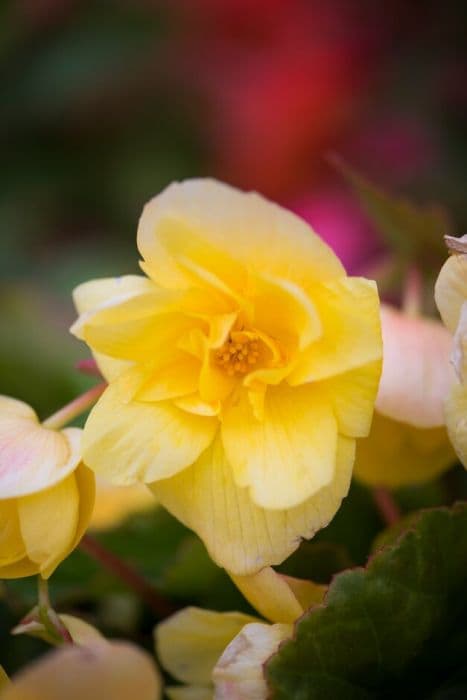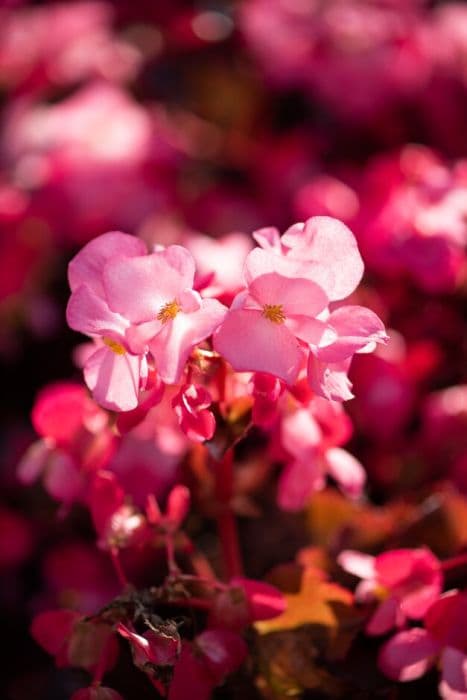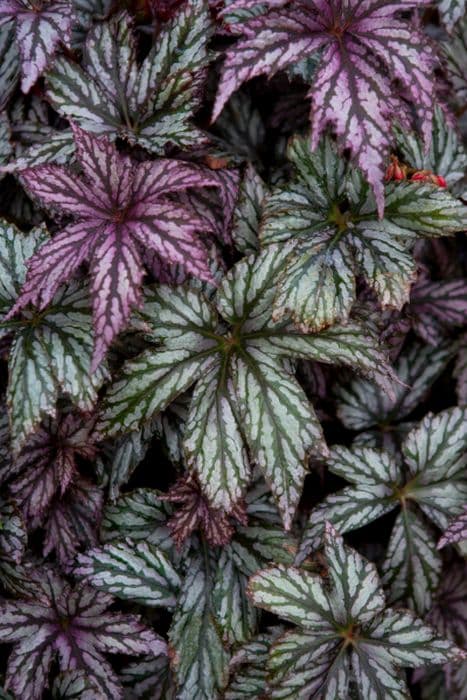Apricot Begonia Begonia 'Illumination Apricot' (Illumination Series) (T/d)

ABOUT
Begonia 'Illumination Apricot' is a vibrant and eye-catching plant known for its striking floral display and luscious foliage. This particular begonia features a cascade of soft apricot to orange-colored flowers that possess a delicate, almost translucent quality. Each individual flower is characterized by its rounded petals that are slightly ruffled at the edges, giving them a full, robust appearance. The blooms hang in abundant clusters, creating a lush overhanging effect that is reminiscent of a floral waterfall. These flowers are complemented by the plant's foliage, which is equally attractive. The leaves are glossy and feature a rich green color, with a heart-shaped base that tapers to a pointed tip. The leaf surface is slightly textured with visible veining, adding depth and interest to the overall appearance of the plant. In terms of growth habit, Begonia 'Illumination Apricot' is known for its trailing nature, making it a popular choice for hanging baskets or as a spiller plant in container arrangements. Its stems are slender yet sturdy, allowing the foliage and blooms to spill gracefully over the edges of whatever container they are placed in. Overall, the combination of its charming apricot flowers and lush greenery makes this begonia a delightful addition to any garden or outdoor space.
About this plant
 Names
NamesSynonyms
Begonia 'Illumination Apricot', Apricot Illumination Begonia, Apricot Illumination Tuberous Begonia.
Common names
Begonia 'Illumination Apricot'
 Toxicity
ToxicityTo humans
Begonias, including the Begonia 'Illumination Apricot', contain compounds that can be irritating when ingested. They contain oxalate crystals, which can cause a burning sensation in the mouth, tongue, and throat. Ingesting parts of the plant might also cause nausea, vomiting, and diarrhea. Contact with the sap may cause skin irritation in sensitive individuals. If large quantities of the plant are consumed, the symptoms could be more severe, but typical household exposure is unlikely to be life-threatening. It is advisable to keep the plant out of reach of children who might chew on it.
To pets
Begonias, such as the Begonia 'Illumination Apricot', are toxic to pets because they contain soluble calcium oxalates. When ingested, these oxalates can cause oral pain, drooling, vomiting, and difficulty swallowing due to the irritation and burning sensation they cause in the mouth, tongue, and throat of the pet. In severe cases, ingestion can lead to kidney failure and other systemic issues, although this is rare. Immediate veterinary care is recommended if a pet consumes any part of the plant. It is best to keep these plants away from pets to avoid any risk of poisoning.
 Characteristics
CharacteristicsLife cycle
Perennials
Foliage type
Evergreen
Color of leaves
Green
Flower color
Apricot
Height
1-2 feet (30-60 cm)
Spread
1-2 feet (30-60 cm)
Plant type
Herb
Hardiness zones
9
Native area
Varies
Benefits
 General Benefits
General Benefits- Vibrant Color: The Begonia 'Illumination Apricot' produces vivacious apricot-orange flowers that add a burst of color to any garden or indoor space.
- Continuous Blooming: This variety blooms throughout the summer months, providing long-lasting floral displays.
- Trailing Habit: With a cascading growth pattern, it's an ideal plant for hanging baskets and containers, creating a waterfall of foliage and flowers.
- Shade Tolerance: Begonias are known for thriving in shaded areas where other plants might struggle, making them perfect for garden spots that get less sun.
- Easy Maintenance: They require relatively low maintenance compared to other flowering plants, which makes them suitable for busy gardeners.
- Drought Resistance: Once established, they can tolerate brief periods of drought, making them resilient in different weather conditions.
- Attracts Pollinators: The flowers can attract beneficial insects like bees and butterflies to your garden, which are important for pollination.
- Varied Usage: These begonias are versatile and can be used in landscape beds, pots, or as a houseplant, depending on your preference and climate.
 Medical Properties
Medical PropertiesThis plant is not used for medical purposes.
 Air-purifying Qualities
Air-purifying QualitiesThis plant is not specifically known for air purifying qualities.
 Other Uses
Other Uses- Edible Decoration: The blossoms of Begonia can be used as a colorful, edible garnish for salads and desserts, adding a bright splash of apricot to dishes.
- Artistic Inspiration: Artists and photographers often use Begonia flowers as subjects for paintings, illustrations, and photo compositions due to their vibrant colors and intricate form.
- Teaching Tool: In educational settings, Begonia plants can be used to teach children about plant biology, pollination, and horticulture.
- Eco-friendly Confetti: Dried petals of Begonia can be used as a biodegradable confetti alternative at celebrations, reducing environmental impact.
- Natural Dyes: The colorful leaves and flowers provide natural dyes for fabrics, yarns, or paper, achieving a range of hues from subtle apricot shades to more vibrant colors.
- Craft Material: Fresh or dried Begonia flowers and leaves can be incorporated into artisanal crafts such as candle making, soap making, or handmade paper.
- Table Arrangements: Small potted Begonias can be used as living table centerpieces for events and receptions, offering a more sustainable option than cut flowers.
- Floral Language: In the language of flowers, Begonias can be used to send a message of caution or a warning, which can be incorporated into unique floral arrangements with specific meanings.
- Scented Sachets: Dried Begonia flowers can be placed in cloth sachets to create a subtly scented item for drawers and closets.
- Garden Therapy: Growing Begonias can be a form of horticultural therapy, promoting relaxation and stress relief for individuals by caring for and nurturing plants.
Interesting Facts
 Feng Shui
Feng ShuiThe Begonia is not used in Feng Shui practice.
 Zodiac Sign Compitability
Zodiac Sign CompitabilityThe Begonia is not used in astrology practice.
 Plant Symbolism
Plant Symbolism- Caution: Begonias are often associated with warnings or caution, perhaps due to their delicate nature or because in some cultures, they can signify a cautious relationship with others.
- Harmony: The balanced and colorful appearance of the 'Illumination' series may symbolize harmony, suggesting a peaceful and tranquil environment.
- Gratitude: Begonias can be a symbol of gratitude, making them an appropriate gift to show appreciation for someone's kindness or friendship.
- Individuality: With its unique and bright apricot coloring, the Begonia 'Illumination Apricot' expresses uniqueness and can encourage individuality and standing out from the crowd.
- Joy: The vibrant and cheery hues of Begonia 'Illumination Apricot' can symbolize joy and happiness, making it a wonderful plant to brighten up a living space.
 Water
WaterFor the Illumination Begonia, it's important to maintain a balance in watering; allow the top inch of soil to dry out before watering again. Typically, this equates to watering approximately once a week, but this can vary depending on environmental conditions. When it's time to water, do so thoroughly, allowing water to run through the pot's drainage holes, which helps prevent salt buildup in the soil. During the active growing season in spring and summer, you may need up to 16 ounces of water every 7 days, depending on the size of the plant and pot. In the cooler autumn and winter months, reduce watering frequency as the plant's growth slows down.
 Light
LightIllumination Begonias thrive in bright, indirect sunlight. A spot near a window that receives filtered light or a location with morning sun and afternoon shade is ideal. Direct afternoon sunlight can scorch the delicate leaves, so it's important to avoid exposure to harsh rays. East or west-facing windows are typically a good choice for providing the light conditions these plants prefer.
 Temperature
TemperatureIllumination Begonias enjoy temperatures between 60 and 70 degrees Fahrenheit (15 to 21 degrees Celsius) during the day and should not be exposed to temperatures below 50 degrees Fahrenheit (10 degrees Celsius) as they are sensitive to cold. They thrive in typical indoor temperatures but should be protected from drafts and sudden temperature changes. The ideal temperature range for robust growth is from 65 to 72 degrees Fahrenheit.
 Pruning
PruningPruning helps maintain an attractive shape in Illumination Begonias and encourages bushier growth. Prune in late winter or early spring before new growth begins. Remove any dead or damaged leaves and stems, and trim up to one-third of the plant to keep it compact. Pruning can be done every few months to remove old flowers and leaves, promoting fresh blooms and foliage.
 Cleaning
CleaningAs needed
 Soil
SoilThe best soil mix for the Illumination Apricot Begonia is a well-draining potting mix with peat, perlite, and vermiculite. Maintain soil pH between 5.5 and 6.5 for optimal growth.
 Repotting
RepottingThe Illumination Apricot Begonia should be repotted every 1 to 2 years to refresh soil and space for root growth.
 Humidity & Misting
Humidity & MistingThe Illumination Apricot Begonia thrives in high humidity, ideally between 50% and 70%.
 Suitable locations
Suitable locationsIndoor
Place in bright indirect light, keep soil moist, high humidity.
Outdoor
Partial shade to filtered sunlight, sheltered, moist soil, mist regularly.
Hardiness zone
10-11 USDA.
 Life cycle
Life cycleThe life cycle of the Begonia 'Illumination Apricot' begins with seed germination in a warm, moist environment, where light is not strictly necessary for the process. Once germinated, the seedlings are pricked out into individual pots when they've developed their first pair of true leaves, after which they enter a period of vegetative growth, producing lush, attractive foliage. As the plant matures, it begins to flower, showcasing its trademark apricot-colored blooms that hang in cascades, which is typical in the growth stage of most begonias in the Illumination series. After flowering, the plant can set seed if pollinated, although many cultivars, including Begonia 'Illumination Apricot', are often propagated via cuttings or division to maintain specific hybrid characteristics. As the temperatures drop or if grown as annuals, the above-ground structure may die back, while the tubers can be overwintered in a cool, dry place to be replanted the next season. With the correct overwintering, the cycle can begin anew with tuberous growth resuming mainly in the spring months, although in some climates, Begonia 'Illumination Apricot' can be grown as a perennial.
 Propogation
PropogationPropogation time
Spring-Early Summer
Propogation: The most popular way to propagate Begonia 'Illumination Apricot' is by stem cuttings. The ideal time to do this is in the spring or early summer when the plant's growth is most active. To propagate, you should choose a healthy stem with at least a couple of leaves and snip it just below a node using sterilized scissors or a knife. The cutting, which should be about 4 inches (approximately 10 centimeters) long, then needs to have its lower leaves removed before being inserted into a mixture of moist peat and perlite. To encourage rooting, you can dip the cut end into a rooting hormone before planting. The cutting should be kept in a bright, warm spot out of direct sunlight, with the soil kept consistently moist but not waterlogged. Roots typically develop within a few weeks, after which the new plant can be transferred into potting soil.





![Begonia [Devotion]](/_next/image?url=https%3A%2F%2Fplants-admin.emdemapps.com%2Fimages%2Fplants%2F%2Fimages%2F604b58183573b.png&w=640&q=75)



